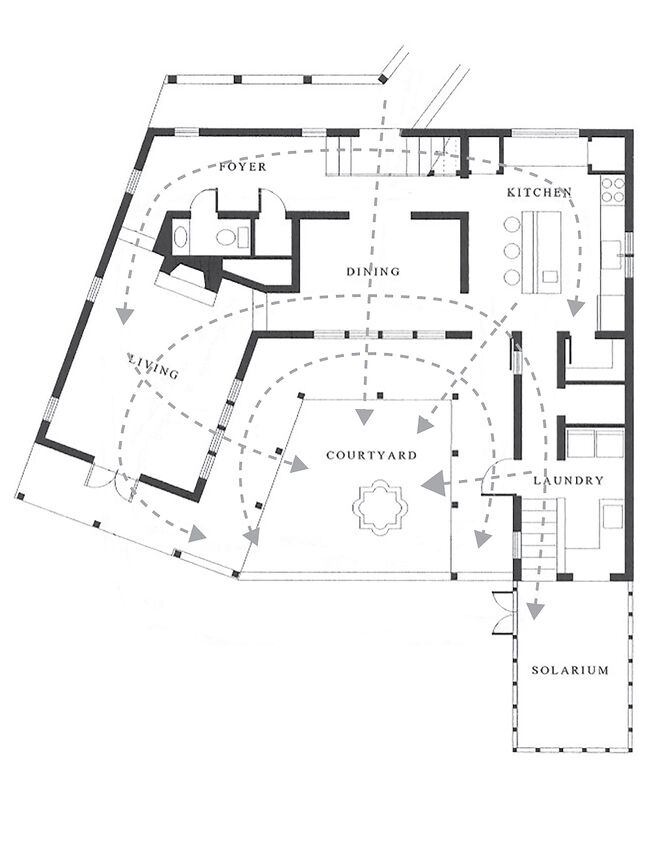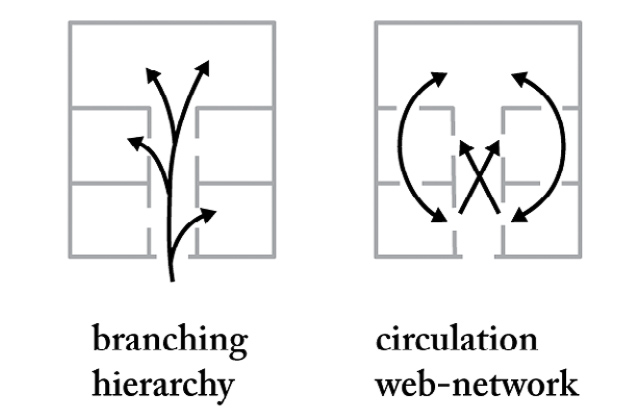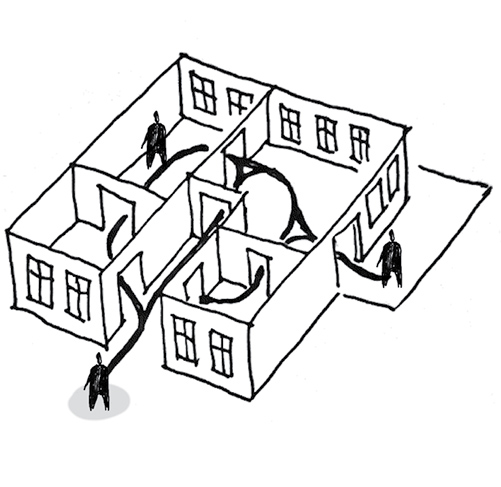10.2. Circulation Network
Aus Pattern Language Wiki
A Courtyard Building (or other larger building with wings) needs to be structured to take advantage of its spatial complexity, without losing coherence.
Problem-statement: Too often, circulation within a building is conceived as an elementary branching hierarchy or “tree” structure. This is a deadening kind of space. The richest spatial experiences come from inter-connected circulatory network structures, offering rich overlapping relationships.
Discussion: A “functional” approach to architectural space typically conceives of a linear, branching relationship: a central hallway “spine” leads to some boxy spaces at the sides, and perhaps to some main space at the end. But a more complex kind of spatial relationship comes from circulation networks, where the spaces are part of a circuit that inter-connects around and sometimes across the spaces.
Looping circuits and redundancy are the keys to successful circulation networks. To avoid pre-determining a linear flow through rooms, create the possibility of choosing from among one or more alternative routes. At the same time, have enough available internal paths that some of them can join into a loop, to avoid being forced to move along only a unique path.
As these circulation networks intersect with adjoining spaces, they can offer views or light, while taking care to protect the privacy of these other spaces — for example, by using high clerestory windows, or frosted panes of glass. In this way, the circulation network can address the experience of people using the building from their perspective, and not just make expert determinations of “functionality.” 1
Therefore:
Do not lay out buildings with long boring central hallways, lacking views or connections. Instead, conceive of building circulation as a sequence of interconnected spaces forming a circulation network, retaining views and inter-connections to all the spaces while also protecting privacy.
Employ Local Symmetry in creating plan elements. Use Layered Zones and Framing to generate complexity and delight. …
¹ A relatively new research field is known as “architectural cognition” — how we see, understand and move through architectural space. See for example Dalton, R. C., Krukar, J., & Hölscher, C. (2018). 19. Architectural cognition and behavior. In Handbook of Behavioral and Cognitive Geography, p. 337-356. Cheltenham UK: Elgar.
Mehaffy, M. et al. (2020). CIRCULATION NETWORK (pattern). In A New Pattern Language for Growing Regions. The Dalles: Sustasis Press. Available at https://pattern-language.wiki/.../Circulation_Network
SECTION I:
PATTERNS OF SCALE
1. REGIONAL PATTERNS
Define the large-scale spatial organization…
1.4. 400M THROUGH STREET NETWORK
2. URBAN PATTERNS
Establish essential urban characteristics…
3. STREET PATTERNS
Identify and allocate street types…
4. NEIGHBORHOOD PATTERNS
Define neighborhood-scale elements…
5. SPECIAL USE PATTERNS
Integrate unique urban elements with care…
6. PUBLIC SPACE PATTERNS
Establish the character of the crucial public realm…
7. BLOCK AND PLOT PATTERNS
Lay out the detailed structure of property lines…
8. STREETSCAPE PATTERNS
Configure the street as a welcoming place…
9. BUILDING PATTERNS
Lay out appropriate urban buildings…
10. BUILDING EDGE PATTERNS
Create interior and exterior connectivity…
10.1. INDOOR-OUTDOOR AMBIGUITY
SECTION II:
PATTERNS OF MULTIPLE SCALE
11. GEOMETRIC PATTERNS
Build in coherent geometries at all scales…
11.2. SMALL GROUPS OF ELEMENTS
12. AFFORDANCE PATTERNS
Build in user capacity to shape the environment…
13. RETROFIT PATTERNS
Revitalize and improve existing urban assets …
14. INFORMAL GROWTH PATTERNS
Accommodate “bottom-up” urban growth…
15. CONSTRUCTION PATTERNS
Use the building process to enrich the result…
SECTION III:
PATTERNS OF PROCESS
16. IMPLEMENTATION TOOL PATTERNS
Use tools to achieve successful results…
16.2. ENTITLEMENT STREAMLINING
16.3. NEIGHBORHOOD PLANNING CENTER
17. PROJECT ECONOMICS PATTERNS
Create flows of money that support urban quality…
17.4. ECONOMIES OF PLACE AND DIFFERENTIATION
18. PLACE GOVERNANCE PATTERNS
Processes for making and managing places…
18.3. PUBLIC-PRIVATE PLACE MANAGEMENT
19. AFFORDABILITY PATTERNS
Build in affordability for all incomes…
19.1. INTEGRATED AFFORDABILITY
20. NEW TECHNOLOGY PATTERNS
Integrate new systems without damaging old ones…
20.2. RESPONSIVE TRANSPORTATION NETWORK COMPANY


